1993 CHEVROLET LUMINA load capacity
[x] Cancel search: load capacityPage 85 of 324
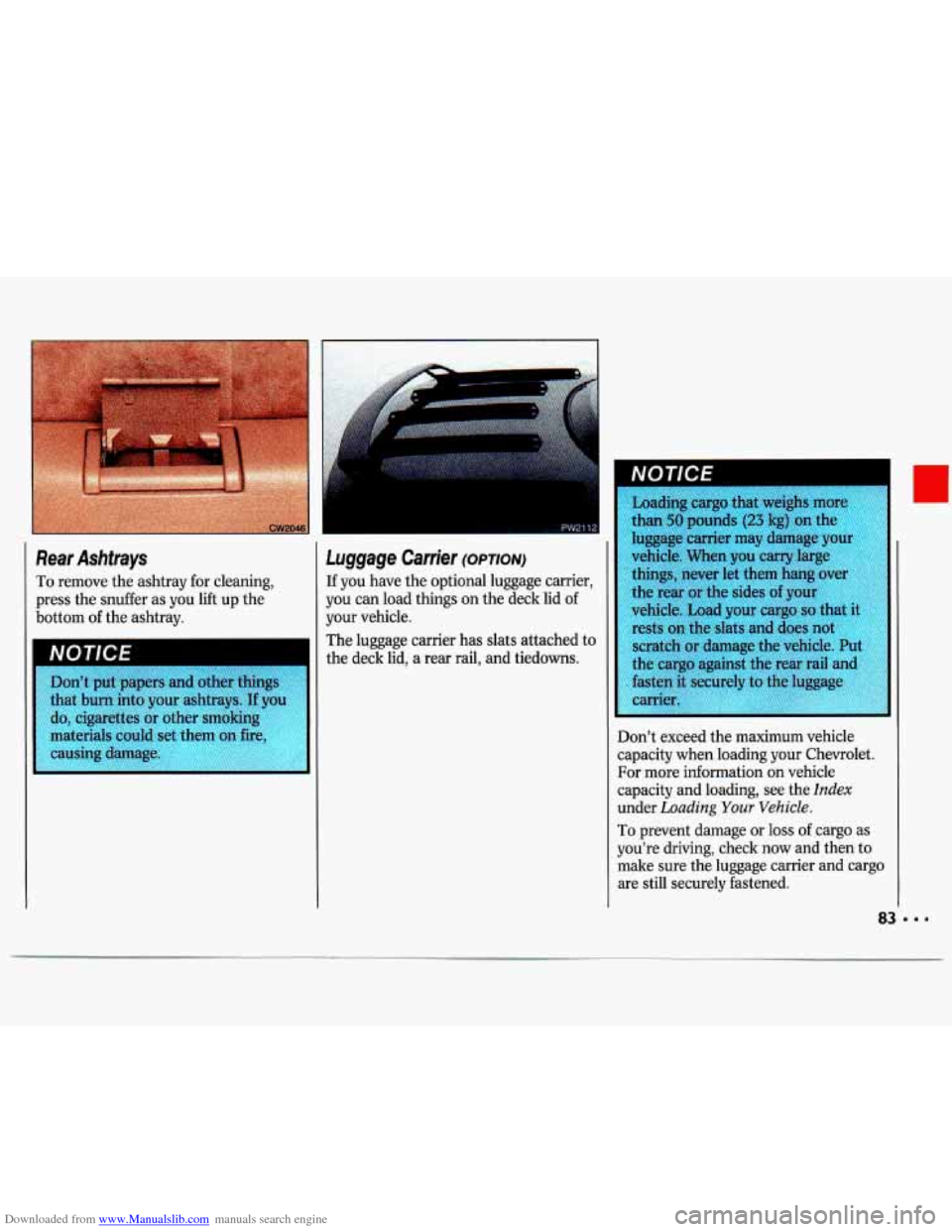
Downloaded from www.Manualslib.com manuals search engine Rear Ashtrays
To remove the ashtray for cleaning,
press the snuffer as you lift up the
bottom
of the ashtray.
Don't put papers and other things
that burn into your ashtrays. If you
do, cigarettes or other smoking
materials could set them on fire,
Luggage Carrier (OPTION)
If you have the optional luggage carrier,
you can load things on the deck lid of
your vehicle.
The luggage carrier has slats attached to
the deck lid, a rear rail, and tiedowns. Loading cargo
that weighs more
than
50 pounds (23 kg) on the
luggage carrier may damage your
vehicle. When you carry large things, never let them hang over
the rear or the sides of your
vehicle. Load your cargo
so that it
rests on the slats and does not
scratch or damage the vehicle.
Pu
the cargo against the rear rail and
Don't exceed the maximum vehicle
capacity when loading your Chevrolet
.
For more information on vehicle
capacity and loading, see the
Index
under Loading Your Vehicle.
To prevent damage or loss of cargo as
you're driving, check now and then to
make sure the luggage carrier and cargo
are still securely fastened.
r
Page 91 of 324

Downloaded from www.Manualslib.com manuals search engine Tachometer (OPTION)
The tachometer displays the engine
speed in revolutions per minute
(rpm) .
I
engine damage may occur.
Fuel Cage
You have one of the fuel gages shown.
The fuel gage tells you about how much
fuel you have left, when the ignition
is
on. When the indicator nears E (Empty),
you still have a little fuel left, but
you
should get more soon.
Here are three things that some owners
ask about. None of these show a
problem with your fuel gage:
At the gas station, with your ignition
on, the gas pump shuts off before the
gage reads
F (Full).
It takes a little more or less fuel to fill
up than the gage indicated. For
example, the gage may have indicated
the tank was half full, but it actually .
took a little more or less than half the
tank's capacity to fill the tank.
The gage moves a little when you turn '
a corner or speed up.
For your fuel tank capacity,
see Service
Station Information
on the last page of
this manual.
8
U
Page 157 of 324
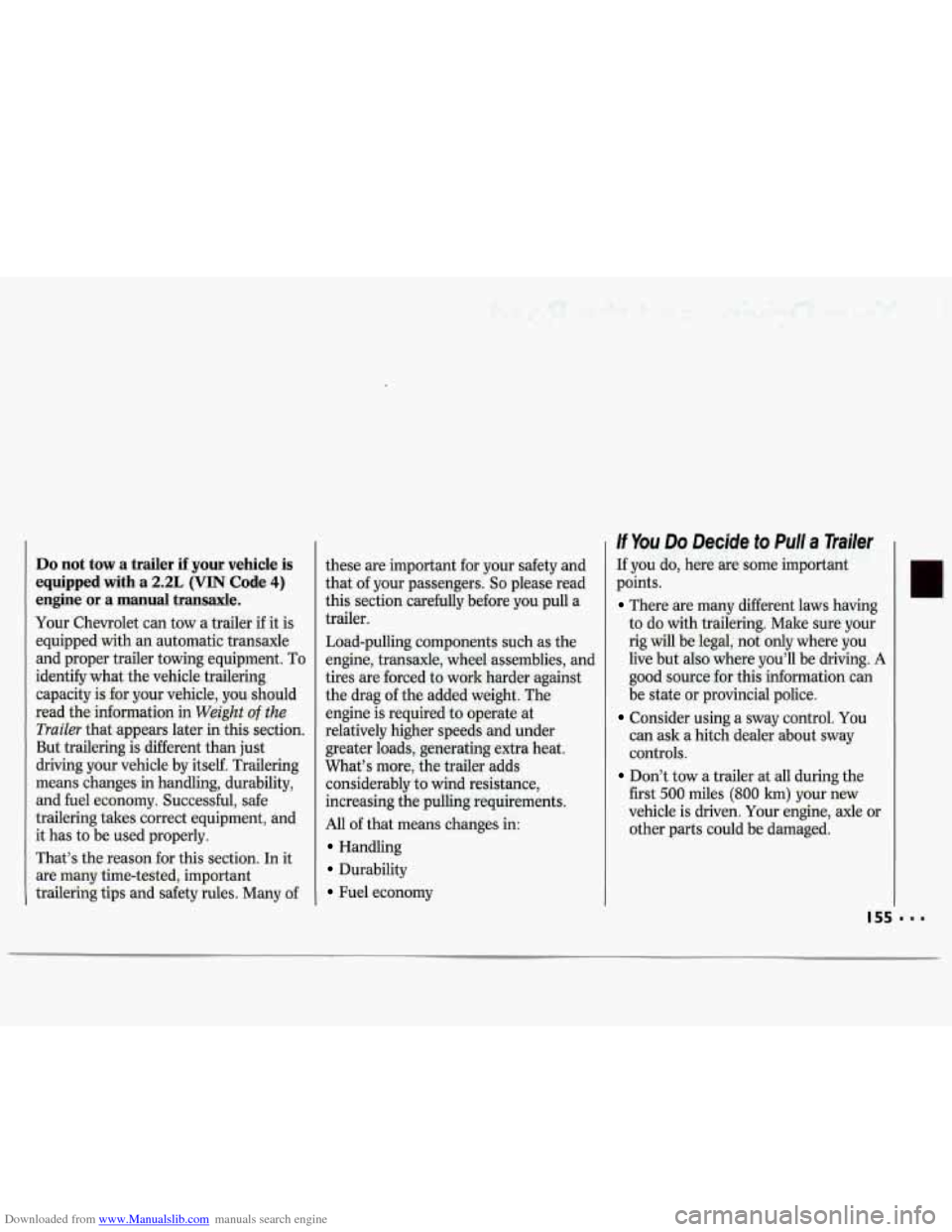
Downloaded from www.Manualslib.com manuals search engine Do not tow a trailer if your vehicle is
equipped with a 2.2L (VIN Code 4)
engine or a manual transaxle.
Your Chevrolet can tow a trailer if it is
equipped with an automatic transaxle
and proper trailer towing equipment. To
identify what the vehicle trailering
capacity is for your vehicle, you should
read the information in
Weight of the
Trailer
that appears later in this section.
But trailering is different than just
driving your vehicle by itself. Trailering
means changes
in handling, durability,
and fuel economy. Successful, safe
trailering takes correct equipment, and
it has to be used properly.
That’s the reason for this section. In it
are many time-tested, important
trailering tips and safety rules. Many of these are important
for your safety and
that of your passengers.
So please read
this section carefully before you pull a
trailer.
Load-pulling components such as the
engine, transaxle, wheel assemblies, and
tires are forced to work harder against
the drag of the added weight. The
engine is required to operate at
relatively higher speeds and under
greater loads, generating extra heat.
What’s more, the trailer adds
considerably to wind resistance,
increasing the pulling requirements.
All of that means changes in:
Handling
Durability
Fuel economy
If You Do Decide to Pull a Trailer
If you do, here are some important
points.
There are many different laws having
to do with trailering. Make sure your
rig will be legal, not only where you
live but also where you’ll be driving.
A
good source for this information can
be state or provincial police.
Consider using a sway control. You
can ask a hitch dealer about sway
controls.
Don’t tow a trailer at all during the
first
500 miles (800 lun) your new
vehicle is driven. Your engine, axle or
other parts could be damaged.
Page 159 of 324
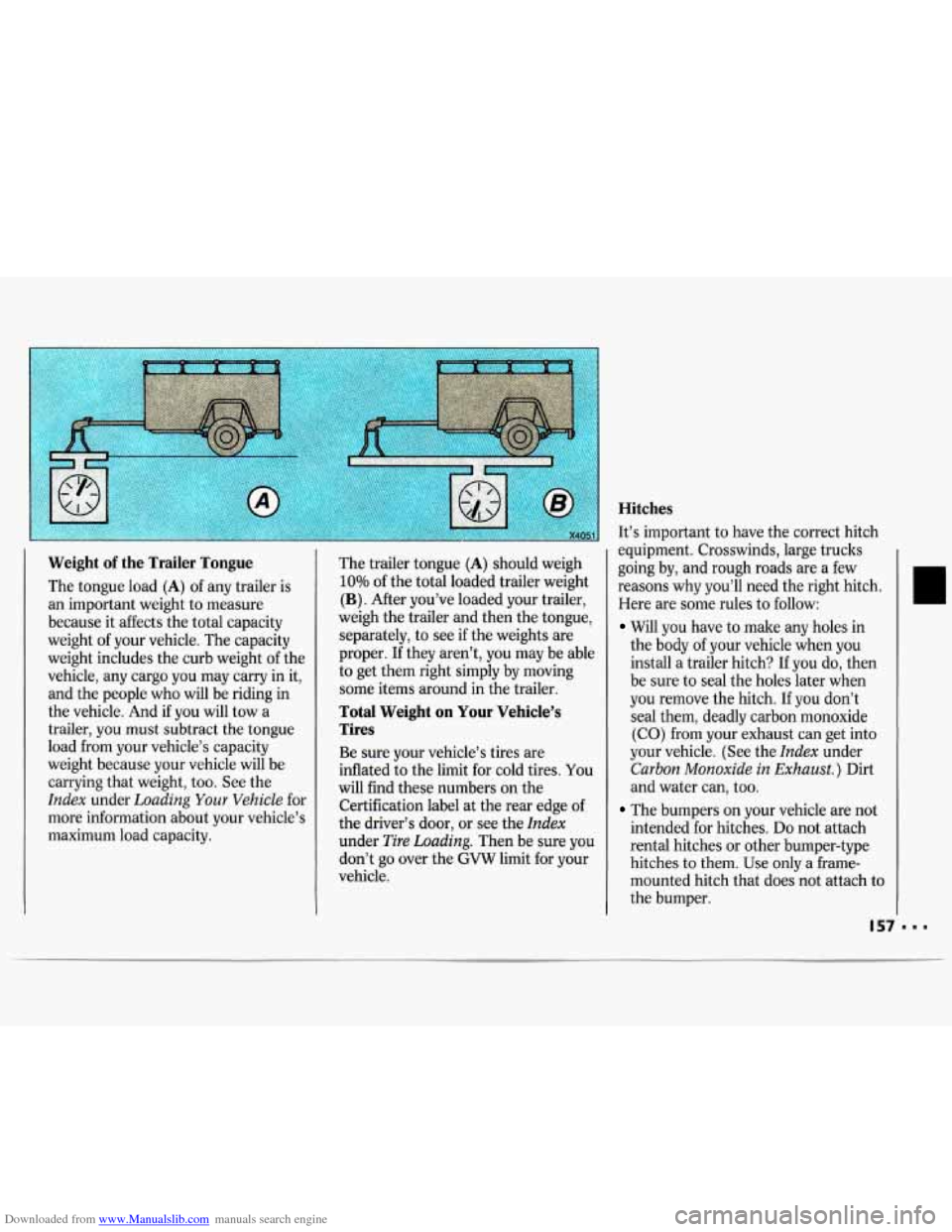
Downloaded from www.Manualslib.com manuals search engine Weight of the Trailer Tongue
The tongue load (A) of any trailer is
an important weight to measure
because it affects the total capacity
weight
of your vehicle. The capacity
weight includes the curb weight
of the
vehicle, any cargo you
may carry in it,
and the people who will be riding in
the vehicle. And
if you will tow a
trailer, you must subtract the tongue
load from your vehicle’s capacity
weight because your vehicle will be
carrying that weight, too. See the
Index under Loading Your Vehicle for
more information about your vehicle’s
maximum load capacity. The trailer tongue
(A) should
weigh
10% of the total loaded trailer weight
(B) . After you’ve loaded your trailer,
weigh the trailer and then the tongue,
separately, to see if the weights are
proper. If they aren’t, you may be able
to get them right simply by moving
some items around in the trailer.
Total Weight on Your Vehicle’s
Tires
Be sure your vehicle’s tires are
inflated to the limit for cold tires.
You
will find these numbers on the
Certification label at the rear edge of
the driver’s door, or see the
Index
under Tire Loading. Then be sure you
don’t
go over the GVW limit for your
vehicle.
Hitches
It’s important to have the correct hitch
equipment. Crosswinds, large trucks
going by, and rough roads are a few
reasons why you’ll need the right hitch.
Here are some rules to follow:
Will you have to make any holes in
the body
of your vehicle when you
install
a trailer hitch? If you do, then
be sure to seal the holes later when
you remove the hitch. If
you don’t
seal them, deadly carbon monoxide
(CO) from your exhaust can get into
your vehicle. (See the
Index under
Carbon Monoxide in Exhaust.) Dirt
and water can, too.
The bumpers on your vehicle are not
intended for hitches.
Do not attach
rental hitches or other bumper-type
hitches to them. Use only a frame-
mounted hitch that does not attach
to
the bumper.
Page 195 of 324
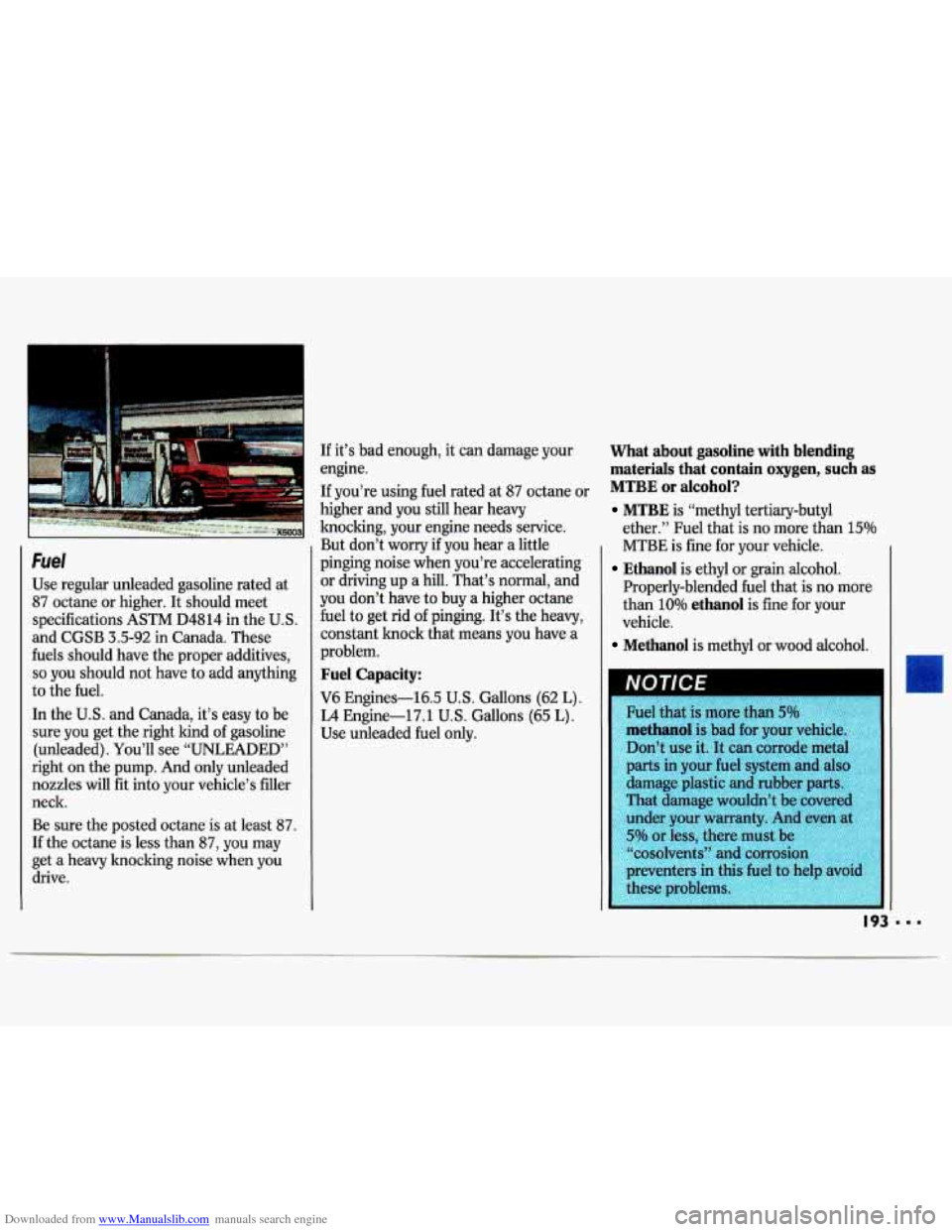
Downloaded from www.Manualslib.com manuals search engine I Fuel
Use regular unleaded gasoline rated at
87 octane or higher. It should meet
specifications ASTM D4814 in the
U.S.
and CGSB 3.5-92 in Canada. These
fuels should have the proper additives,
so you should not have to add anything
to the fuel.
In the
U.S. and Canada, it’s easy to be
sure you get the right kind of gasoline
(unleaded). You’ll see “UNLEADED”
right on the pump. And only unleaded
nozzles will fit into your vehicle’s filler
neck.
Be sure the posted octane is at least
87.
If the octane is less than 87, you may
get a heavy knocking noise when you
drive. If
it’s bad enough, it can damage your
engine.
If you’re using fuel rated at
87 octane or
higher and you still hear heavy
knocking, your engine needs service. But don’t worry if you hear a little
pinging noise when you’re accelerating
or driving up a hill. That’s normal, and
you don’t have to buy a higher octane
fuel to get rid of pinging. It’s the heavy,
constant hock that means you have a
problem.
Fuel Capacity:
V6 Engines-16.5 U.S. Gallons (62 L).
L4 Engine--17.1 U.S. Gallons (65 L).
Use unleaded fuel only.
What about gasoline with blending
materials that contain oxygen, such
as
MTBE or alcohol?
MTBE is “methyl tertiary-butyl
ether.” Fuel that is no more than
15%
MTBE is fine for your vehicle.
Ethanol is ethyl or grain alcohol.
Properly-blended fuel that is
no more
than 10%
ethanol is fine for your
vehicle.
Methanol is methyl or wood alcohol.
I NOTEE
Fuel that is more than 5
methanol is bad for you
Don’t use it. It can corr
parts in your fuel system
and also
damage plastic and rubber parts.
That damage wouldn’t be covered
under your warranty. 5% or less, there mus
“cosolvents” and corrosi
Page 203 of 324
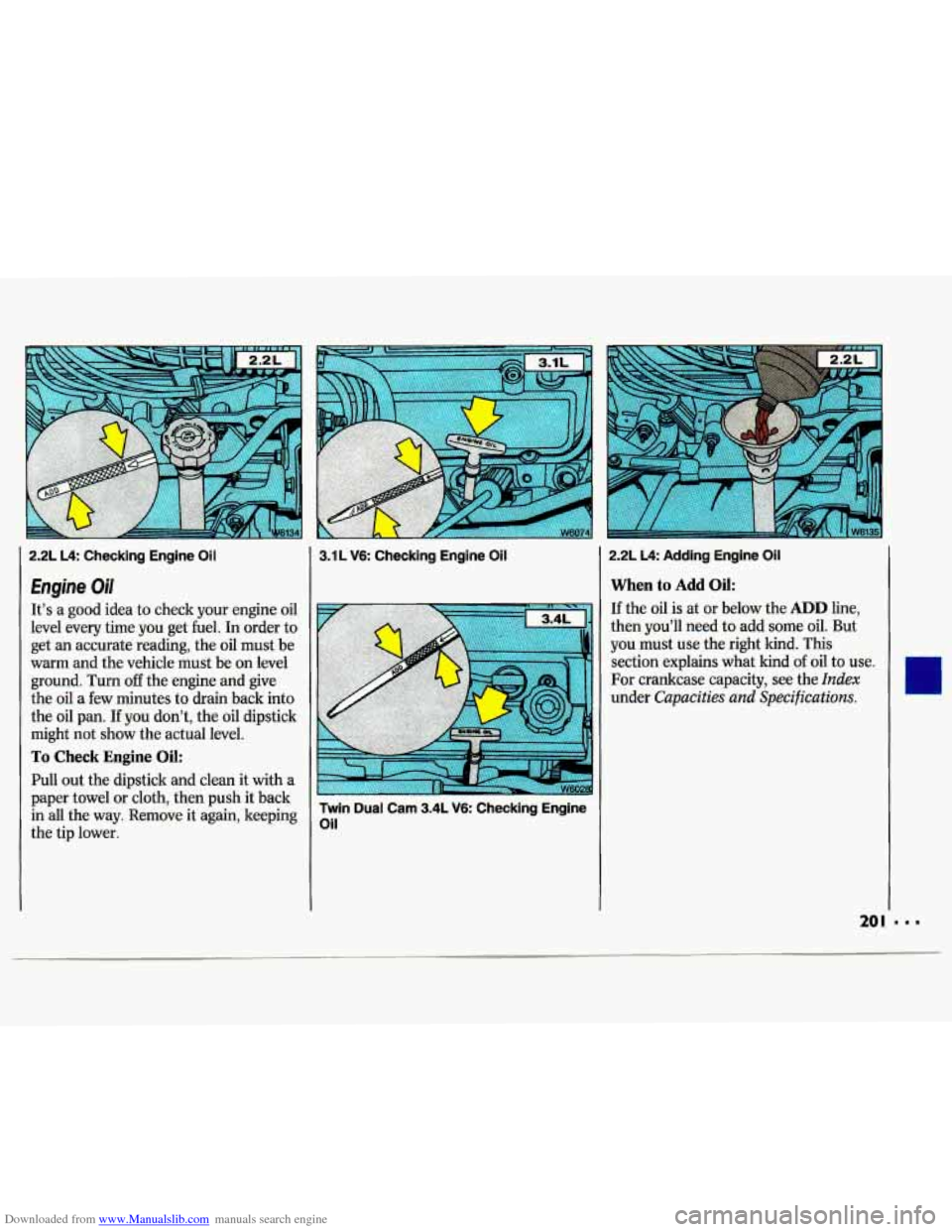
Downloaded from www.Manualslib.com manuals search engine I 2.2L L4: Checking Engine Oil
Engine Oil
It’s a good idea to check your engine oil
level every time you get fuel. In order to
get
an accurate reading, the oil must be
warm and the vehicle must be on level
ground. Turn
off the engine and give
the
oil a few minutes to drain back into
the oil pan. If
you don’t, the oil dipstick
might not show the actual level.
To Check Engine Oil:
Pull out the dipstick and clean it with a
paper towel
or cloth, then push it back
in all the way. Remove it again, keeping
the tip lower.
3.1 L V6: Checking Engine Oil
Twin Dual Cam 3.4L
V6: Checking Engine
Oil 2.2L L4: Adding Engine Oil
When to Add Oil:
If the
oil is at or below the ADD line,
then you’ll need to add some oil. But
you must use the right kind.
This
section explains what kind of oil to use.
For crankcase capacity, see the
Index
under Capacities and Specifications.
Page 204 of 324
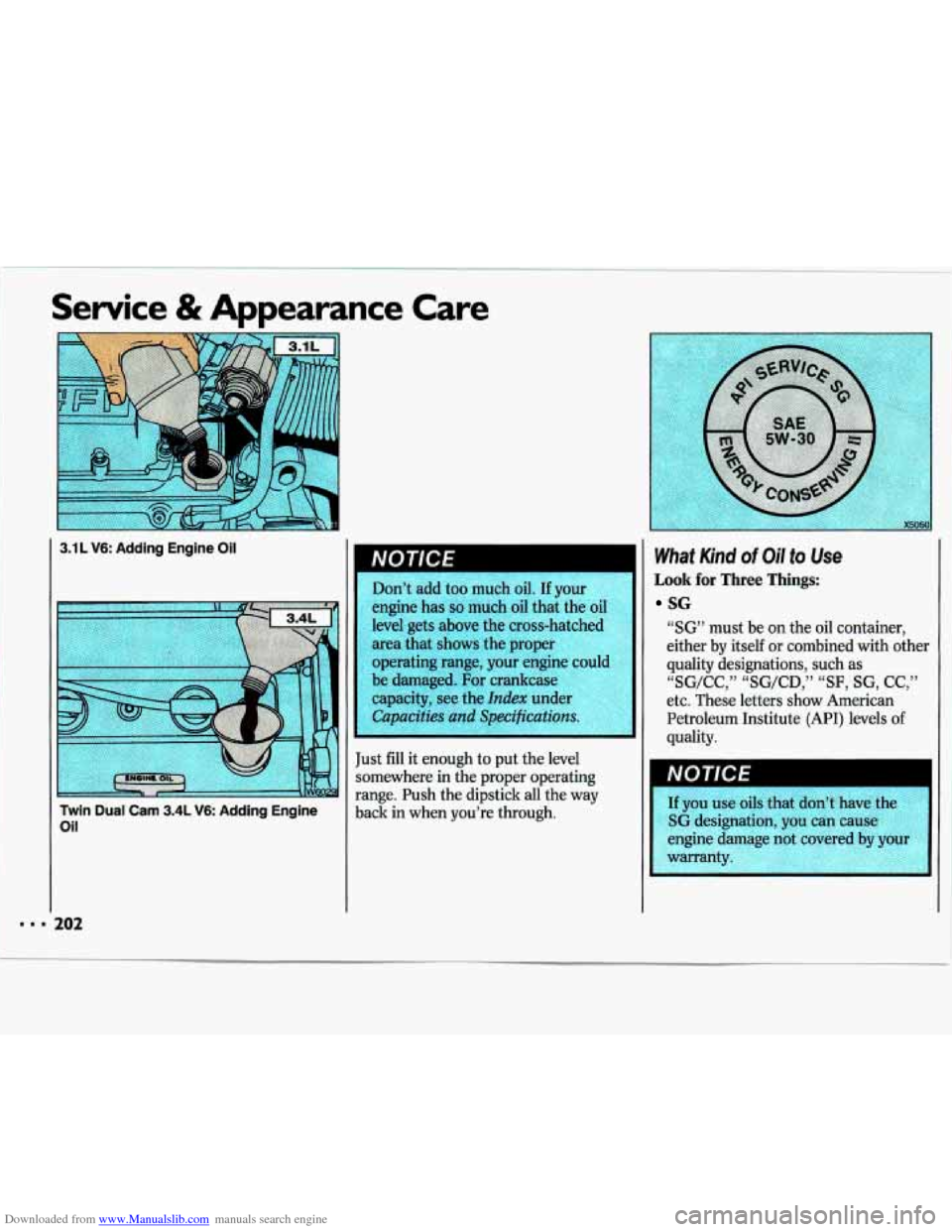
Downloaded from www.Manualslib.com manuals search engine Service & Appearance Care
3.1 L V6: Adding Engine Oil II
. . a 202
Twin Dual Cam 3.4L V6: Adding Engine
Oil
111 Don’t add too much oil. If your
engine has
so much oil that the oil
level gets above the cross-hatched
area that shows the proper
operating range, your engine could
be damaged. For crankcase capacity, see the
Index under
Capacities and Specifications.
’,
Just fill it enough to put the level
somewhere
in the proper operating
range. Push the dipstick all the way
back in when you’re through.
I What Kind of oil to Use
I
Look for Three Things:
SG
“SG” must be on the oil container,
either by itself
or combined with other
quality designations, such
as
“SG/CC,” “SG/CD,” “SF, SG, CC,”
etc. These letters show American
Petroleum Institute (API) levels
of
quality.
I NVIIUL:
If you use oils that don’t have the I
SG designation, you can cause
engine damage not covered by your
1
warranty. I
Page 226 of 324

Downloaded from www.Manualslib.com manuals search engine Service & Appearance Care
= = 224
Windshield Wiper Blade
Replacement
Replacement blades come in different
types and are removed in different
ways. Here’s how to remove the type
with a release clip:
1. Pull the windshield wiper ann away
2. Lift the release clip with a
from
the windshield.
screwdriver and pull the blade
assembly
off the wiper arm.
the wiper arm.
3. Push the new wiper blade securely on
Loading Your Vehicle
Two labels on your vehicle show how
much weight it may properly carry. The
Tire-Loading Information label found
on the inside of the trunk lid tells you
the proper size, speed rating and
recommended inflation pressures for
the tires on your vehicle. It also gives
you important information about the
number of people that can be in your
vehicle and the total weight that you
can carry. This weight is called the
Vehicle Capacity Weight and includes
the weight of all occupants, cargo, and
all nonfactory-installed options. The
other label is the Certification label,
on the rear edge
of the driver’s door. It
tells you the
gross weight capacity of
your vehicle, called the GVWR (Gross
Vehicle Weight Rating). The
GVWR
includes the weight of the vehicle, all
occupants, fuel and cargo. Never exceed
the GVWR for your vehicle, or the
Gross Axle Weight Rating
(GAWR) for
either the front or rear axle.
And,
if you do have a heavy load, you
should spread it out. Don’t carry more
than
167 lbs. (75 kg) in your trunk.